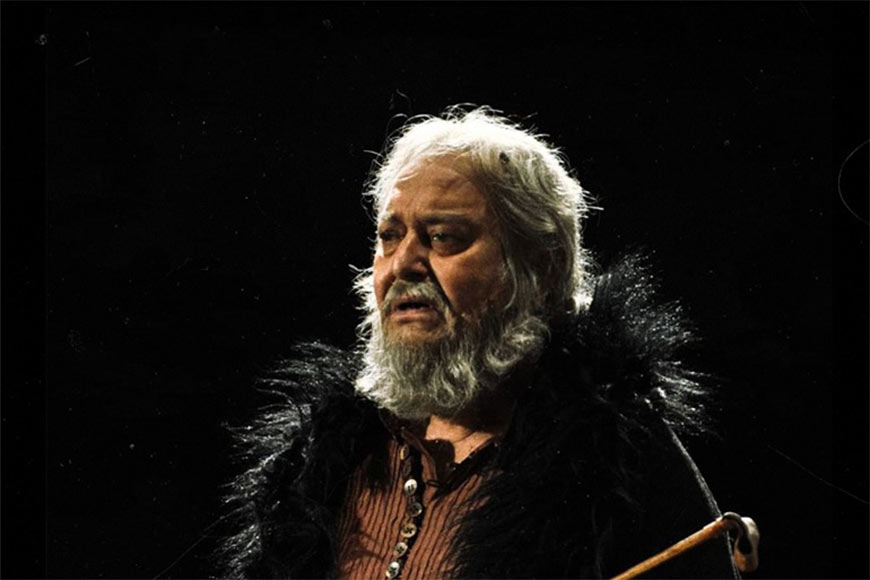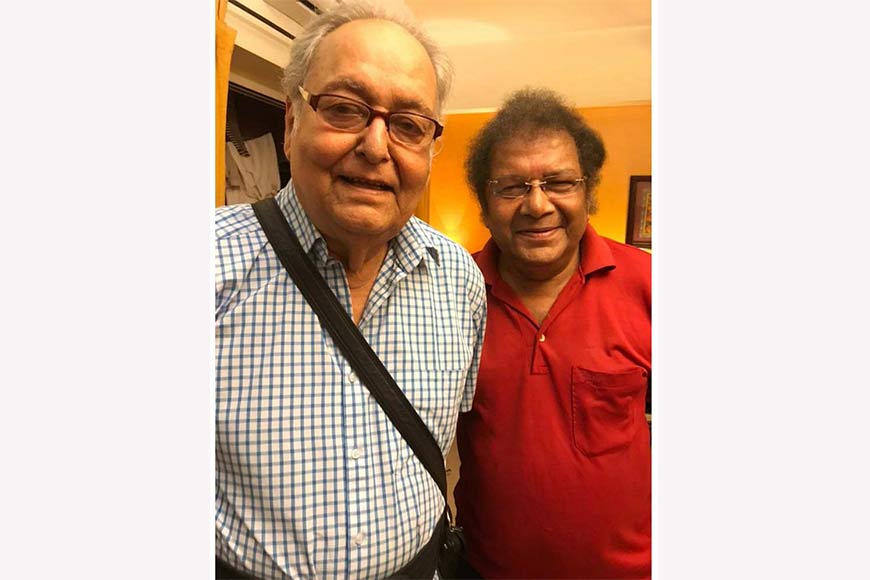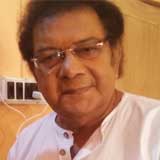Our last bastion, Soumitra da

We are in the midst of a cultural crisis.
Soumitra Chattopadhyay, the lifeblood of our cultural milieu, left us after a relentless battle for survival. The steps of our cultural edifice are etched with gold, thanks to his cultural richness. Poetry, plays, essays, directing plays, acting in them, painting, acting in films – he has made each of these spheres his own. Admittedly, a majority of people will remember Soumitrada only as an actor, but even there, he has stamped every role that he has played with his unique sensibilities and sensitivity. Those sensibilities arise primarily from his view of life, a view that has been shaped by his tireless quest for cultural excellence.
I first met Soumitrada around the middle of 1980. On the floor below my advertising agency office on Shakespeare Sarani was Admakers Sound Recording Studio, and Soumitrada had come in to meet Admakers chief Arup Guhathakurta. I was in the studio, too, recording for HMV’s radio show, ‘Sangeetanjali’
He may have been too old for a college-going Apu’s character in ‘Aparajito’, but the handsome young man had made an impression on Satyajit Ray, which is how ‘Apur Sansar’ became the starting point for what can only be described as an adventure in acting.
Biplab Dasgupta with Soumitra Chattopadhyay and Anashua Majumdar
I first met Soumitrada around the middle of 1980. On the floor below my advertising agency office on Shakespeare Sarani was Admakers Sound Recording Studio, and Soumitrada had come in to meet Admakers chief Arup Guhathakurta. I was in the studio, too, recording for HMV’s radio show, ‘Sangeetanjali’. Even at that brief first meeting, I recognised his effortless articulation, his enviable command over Bangla, and his deep and varied consciousness. Devoted to Uttam Kumar as I was, I still couldn’t help admiring Soumitrada. the sincerity of my respect for him was unmistakable.
Our bond grew stronger as I became the scriptwriter for the TV series ‘Astha’, followed by quite a few films in which I was fortunate to share the screen with him. I remember gathering up the courage to ask, “Soumitrada, what do you think of Uttam Kumar?” His reply redoubled my respect for him. “We were shooting for ‘Jodi Jantem’, and Uttamda asked me what I was doing after the shoot. I said, nothing much. He said, ok then, we’ll have chat. It was the last shot of the day, and Uttamda was having trouble pronouncing a particular word, which meant it couldn’t be okayed. I told him, since the screenplay writer was at hand, why not get him to change that word? But he wouldn’t agree. Suddenly, he told me, ‘Pulu, can you step outside for a while?’ I was taken aback. Why was I being asked to leave? But I had to go. A little later, Uttamda came out and asked me for a smoke. And I asked him why he had wanted me to leave. He said, ‘Your diction is so clear that I was becoming self-conscious in your presence.’ That should tell you how humble the man was.”
It was almost 10.00 p.m. then. That night, we chatted until a quarter to one. And almost every minute of those nearly three hours was like an education. It was then that I received a clear idea of Soumitrada’s views about Sisir Bhaduri’s style of acting, and how Saumitrada had used his nearness to the great man to improve his own style.
However, the acknowledgment of humility requires one to be humble, too. Once, rehearsing for Tamal Roy Chowdhury’s play ‘Ostomukhi Chand’, I received an urgent call from my wife, asking me to rush home at once. But she wouldn’t say why. Intensely worried and anxious, I skipped the rest of the rehearsal and drove home in a daze. Running up four flights of stairs (we don’t have a lift), I was gasping for breath as I rang the doorbell. When Ruma (my wife) opened the door, the first thing I saw was Soumitrada sitting in our drawing room, along with Dwijen Bandyopadhyay. He said, “Thought I’d drop in. We were passing by and Dwijen pointed out your house. So I told him, Biplab keeps asking me to visit, let’s see if he’s at home!” But why had my wife made such a frantic call? Soumitrada laughed and said, “Why blame her? Imagine opening the door to find Soumitra Chatterjee standing outside. It’s natural for her to be startled.”
It was almost 10.00 p.m. then. That night, we chatted until a quarter to one. And almost every minute of those nearly three hours was like an education. It was then that I received a clear idea of Soumitrada’s views about Sisir Bhaduri’s style of acting, and how Soumitrada had used his nearness to the great man to improve his own style. It became clear that Sisir Bhaduri’s style was also Soumitra Chattopadhyay’s style, a tradition that he has nurtured all his life. His unfailing love for theatre has enabled him to effortlessly carve his place in both commercial and academic theatre.
‘Naamjibon’, ‘Rajkumar’, ‘Phera’, are among the plays that Bagbazar Theatre has successfully staged, not just under his direction, but also his writing and acting. With equal success, he has found place in parallel theatre with plays such as ‘Pran Tapasya’ and ‘Homapakhi’. During that night’s conversation, the other thing that struck me was Soumitrada’s boundless energy and life force, which have taken him from one project to another, despite his age. A shining example would be ‘Raja Lear’. Those who have seen the play will know that this is perhaps his best work, notwithstanding age. ‘The Visit, written by Friedrich Dürrenmatt, was the basis for ‘Phera’, which he staged again. This was probably Soumitrada’s greatest tribute to Dürenmatt, Ingrid Bergman, and Anthony Quinn.
One day, sipping tea, Soumitrada spoke about how, after his marriage, three people were most eager to show him around Bombay – Kishore Kumar, Abhi Bhattacharya, and Hemanta Mukhopadhyay. Now Hemanta had taken Soumitrada and his wife Deepa to a museum, from where they came out and stopped to eat phuchka by the roadside, at around 11.30 in the morning.
The next time I had an opportunity to work with him for an extended period was when we were working on an audio album for Tagore’s ‘Golpoguchho’, produced by Naba Nalanda. I was to dramatize and direct eight Tagore short stories, to be read by Soumitrada. On our way to the recording studio, during recording breaks, the conversation flowed as Soumitrada recounted his memories, big and small.
One day, sipping tea, Soumitrada spoke about how, after his marriage, three people were most eager to show him around Bombay – Kishore Kumar, Abhi Bhattacharya, and Hemanta Mukhopadhyay. Now Hemanta had taken Soumitrada and his wife Deepa to a museum, from where they came out and stopped to eat phuchka by the roadside, at around 11.30 in the morning. As they waited, Deepa asked Hemantada whether his first song had been ‘Nikhil Je Lipikhani’, upon which Hemantada said no, his first song had been ‘Jaanite Jodi Go Tumi Pashane Ki Byatha Achhe’. Thereafter he proceeded to sing the entire song, standing on that pavement. As Soumitrada said, “Can you imagine? Hemanta Mukhopadhyay, standing by the side of a busy street in Bombay in broad daylight, singing his heart out!”
 With Soumitra Chattpadhyay.
With Soumitra Chattpadhyay.
Many more such gems lie scattered along the lanes and by lanes of memory, some of which easily find their way out of the mind’s treasure chest. It is my infinite good fortune that a creative legend like Soumitrada introduced my own album of recitations and story readings, titled ‘BondhoKoro Na Pakha’. Explaining why he had agreed to do it, he clearly said that in his opinion, I was trying to save the Bengali language, and that he would always support any such attempt, whether mine or anyone else’s.
Today, this rare individual is no longer with us. A creative intellectual, whose education and depth have bolstered our cultural base. I fear that in his absence, the pillars of our culture will decay and collapse. Because Soumitrada is, quite possibly, the last great pillar of the culture we call ours.











